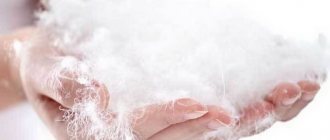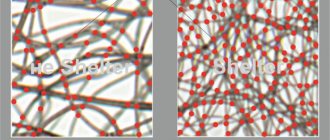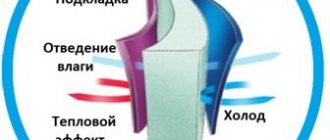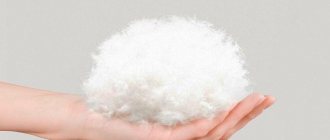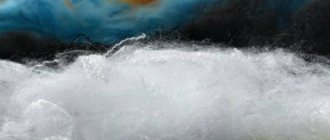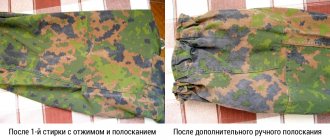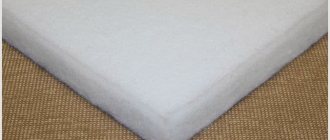What is holophane filler, its features
Hollophan is a filler made from high quality hollow polyester fiber. The material used has been certified and is completely safe for health. As a result of processing polyester, the fiber is formed into soft elastic springs, giving the filler improved properties.
The material is manufactured with different densities. The higher it is, the greater the frost it can withstand. The standard provides for indicators from +5 to -35 °C.
Holofan is a name derived from two words: “hollow” - “hollow” and “fan” - part of the name of the St. Petersburg factory “Fanema”, which produces the filler.
Mode of production
The name Holofan is a merger of the English word “hollow”, which means “hollow”, and the first letters of the name of the factory - “fan”. Like many other modern insulation and fillers, it is made from hollow polyester fiber (polyester), twisted in a spiral and intertwined in a chaotic manner, bonded with biocomponent fusible fiber (using the thermal bonding method).
Thanks to this structure, the material retains heat well and does not allow cold to pass through, without forming a “greenhouse effect”, as it quickly removes moisture. They produce canvas with a width of 1.5 or 2.2 meters and a density of 100-350 g/m2, color white.
Types and properties
The manufacturer offers three types of holophane:
- The usual filler without additives or special impregnation is soft, elastic, voluminous, has thermal insulation properties, is well ventilated and dries quickly. Products with regular holophane are hypoallergenic and environmentally friendly.
- Material with natural additives - usually sheep wool (30%) is added. Thus, the filler acquires additional properties, since wool has a healing effect. Wool shares this unique ability with hollophane. Bedding with this filler is often recommended for diseases of the musculoskeletal system. Products with a mixed type of filler, while maintaining the properties of the synthetic material, acquire healing characteristics.
- Siliconized holophane is characterized by increased elasticity and wear resistance. Bedding made from it withstands numerous washes better and lasts several years longer.
Maybe you will be interested to know what the features of blankets made from natural sheep wool are - the pros and cons.
Properties of domestic material: advantages and disadvantages
Holofan insulation has many positive properties. This is a lightweight material that retains heat well even in severe frosts. Despite its synthetic origin, it allows air to pass through without creating a greenhouse effect. Snow and rain are not afraid of Hollofan outerwear, as this material is waterproof (its humidity is only 0.7%). Other advantages of insulation:
- elastic, completely restores its shape after compression;
- does not absorb odors;
- hypoallergenic;
- environmentally friendly;
- antimicrobial (pathogenic microorganisms do not grow in it);
- wear-resistant.
At the same time, the material is resistant to extremely low and high temperatures, as well as to acids and alkalis. It is easy to care for, dries quickly after washing and is relatively inexpensive. The disadvantage of such insulation is the tendency to accumulate electrostatic charges and the excessive volume of the densest type of holophane.
Where is holophane used?
The range of applications of holophane is wide. It is used
- at home;
- in construction;
- furniture production;
- when sewing textile products (clothing, bedding).
The material is rarely used in households, furniture production and construction. Hollophan is not the cheapest synthetic insulation. More often it is used when sewing warm clothes, workwear, pillows, blankets, and for stuffing children's soft toys.
Clothes with holofan, including children's (the material is absolutely safe), are produced in two types: demi-season and winter. Depending on the density of the filler used, it is suitable for +5 °C (125 g/m2), but can withstand -35 °C (325 g/m2).
Bedding with holofan is a product that can provide a healthy, comfortable sleep and complete restoration of strength. The pillows are different
- softness;
- elasticity;
- the ability to quickly restore shape;
- wear resistant.
Blankets are appreciated
- for excellent thermal insulation;
- softness;
- breathability;
- lightness, fluffiness.
Important! The material has found application in the production of tourism goods: suits, sleeping bags.
Comparison of holophane with other fillers
Holofan is a unique insulation material that has its own characteristics; in particular, it is often compared with padding polyester and natural down.
"Clone" of padding polyester?
Some buyers claim that holofan is a more expensive version of padding polyester. However, the difference between them is quite impressive:
- Hollophan is distinguished by its great elasticity - after creasing, it completely restores its shape, while synthetic winterizer recovers from deformation only by 70–80%. And the new material wrinkles 30–40% less than synthetic insulation,
- inexpensive synthetic winterizer is made, as a rule, using harmful synthetic glue, which can cause allergies when destroyed,
- Holofan is 30% warmer and at the same time more compact,
- synthetic winterizer has poor air permeability and is not suitable for extreme frosts,
- synthetic winterizer has the effect of a “heat gun”, carries the risk of overheating,
- With frequent washing, the padding polyester insulation clumps into a lump.
The comparison between padding polyester and holofane is explained by the fact that they are made from the same polyester fibers, but the fibers of padding polyester are not twisted or hollow, unlike holofane. As well as some additional components and completely different production technologies, their properties are very different.
When the youngest child was still small, he received an almost new jacket with padding polyester from the eldest. I must say that I had never washed it before, but only wiped it with a damp sponge to remove dust and surface dirt. But after the youngest’s masterful mud rolling, it was the jacket’s turn to go into the machine wash. After removing it from the drum, I even doubted: was there fluff inside? My doubt was caused by the fact that between the seams the filler was collected into lumps of different diameters. As a result, in order not to throw the item away, I ripped it open from the inside, smoothed out the padding polyester, and sewed it to the top layer of the raincoat fabric with invisible seams.
Unpretentious substitute for natural down
Both insulation materials have excellent thermal insulation properties, but holophane:
- is not afraid of wet cleaning, does not lose its shape, forming clumps,
- continues to retain heat well after washing,
- does not cause allergies,
- does not absorb moisture, microorganisms do not multiply in it,
- suitable for any weather,
- has an affordable price compared to natural down.
Advantages and disadvantages of filler
Synthetic filler is not inferior in quality to natural ones. Its main advantages:
- softness, lightness, volume;
- breathability;
- thermal insulation;
- elasticity, resistance to deformation and the ability to quickly restore shape;
- the material does not accumulate dust and does not absorb odors, therefore it is used as hypoallergenic;
- practicality, wear resistance, resistance to aggressive environments;
- bed mites and insects are not capable of living in the material;
- does not absorb moisture.
There are practically no shortcomings in the material. The filler can accumulate static electricity and spark, but treating the fiber with an antistatic agent solves this problem; excess volume can also be noted.
Advantages of insulation
The hollow fiber structure allows for excellent heat retention without trapping moisture inside. The latter property is ensured by the exceptional porosity of the material, which allows it not to absorb sweat, moisture from rain or snow. The thermal insulating properties of holophane allow it to be compared with natural down, but it also has its own specifics that distinguish the material for the better:
- there is no effect of accumulation of moisture and foreign odors,
- hypoallergenic,
- does not deform or deteriorate during washing,
- in clothes with such filling you will not overheat,
- maintaining shape regardless of the frequency of use and maintenance,
- removal of moisture in an accelerated time,
- production from non-toxic materials.
Holophane filler: reviews
Hollophan has earned only positive reviews from customers who have chosen sleep products and clothing with this filling. Everyone talks about it as a soft, warm material. The main thing is to choose the right density that matches the weather conditions. Tourists who use sleeping bags with holophane speak especially flatteringly about it. Buyers are satisfied with the practicality and wear resistance of products with this filler, ease of care, the products dry quickly as they repel moisture. Mothers, when choosing winter clothes for children, prefer models with holofan.
Fillings in children's winter clothing
10/19/2016 Winter is coming, which means it’s time to warm up. To make your choice easier, Children's Town has prepared a review of the fillings used by children's clothing manufacturers.
Natural fillers:
- Natural fluff
In down jackets and coats, the percentage of down and feather is very important. In a good down jacket it is from 60%/40% to 80%/20%, where the first number is the amount of down. There is no such thing as 100% fluff.
Down fibers are very mobile, which eliminates the possibility of down “climbing” to the surface. All seams on down clothing also undergo special treatment.
It is also necessary to take into account that down is an allergen and an excellent breeding ground for mites, so its antibacterial treatment is very important. Also, one of the main disadvantages of down is its ability to absorb moisture and certain difficulties when washing.
Children's winter overalls with eider down, designed for walking in severe frosts. Goose down is also good. Duck down as insulation is best suited for demi-season clothing. Down clothes are best worn in areas with a dry, frosty climate; in non-frosty, wet winters, down children's clothing can contribute to the greenhouse effect and the child may overheat.
Down (in addition to using other fillers) is produced by the following companies: BILEMI, STEEN AGE, Arctiline (Russia), Chicco (Italy), O'Hara (Canada), Il Gufo (Italy), Zera (Spain), Premaman (Belgium) and etc.
- Sheepskin or wool
The advantages of this material include its durability, hypoallergenicity and wear resistance. Wool retains heat well, but at the same time absorbs moisture well and has a lot of weight.
Retains heat perfectly down to -25°.
- Modern Alpolux® insulation
Products made from Alpolux® insulation are incredibly light and warm, thanks to the combination of high-quality microfiber and natural merino wool. Alpolux® is an absolutely environmentally friendly product that is made only from primary raw materials. Primary raw materials do not contain impurities (e.g. broken glass, crumbs, dust, dirt) that are present in secondary raw materials, because This is the recycling of all kinds of garbage.
Alpolux® insulation was developed by Austrian experts specifically for Russian weather conditions, based on the European traditions of using wool for the manufacture of outerwear.
Synthetic fillers:
Termofin
Termofinn is a combination of hollow, highly crimped and biocomponent fibers, thermally bonded at high temperatures. Termofinn is made only from primary raw materials - an environmentally friendly product LIGHT WARM SOFT.
More voluminous and stable - due to a special production technology - 80% of the fibers are bonded vertically in the layer. Easy to cut and sew. Environmentally friendly product - SAFE FOR CHILDREN. Retains its shape well after washing and dries quickly. Withstands long-term storage and does not require special storage conditions. Thinsulate
“Thinsulate” is a fiber that is 50-70 times thinner than a human hair. It’s very, very elastic - no matter how you look at it, it still holds volume, and there is a lot of air in this volume due to the microscopic thinness of the fibers. And air is the best insulator of cold.
Thinsulate has the highest international quality certificate ISO 9002, it is hypoallergenic and has excellent hygienic properties. Recommended for those suffering from allergies and asthma.
Advantages:
- The lightest of all synthetic fillers
- 1.5 times warmer than natural down
- Has unique thermoregulating properties
- Does not absorb moisture
- Retains its shape perfectly after washing and drying
- Does not cause allergies
- Has a European environmental certificate
- Children's clothing using Thinsulate (in addition to other fillers) is produced by the following companies: Ketch (Sweden), TALVI / Talvi (Russia), atPlay (Canada), DONILO, Gulliver, Heinrich Nickel GmbH (Germany), etc.
Isosoft
Synthetic insulation Isosoft (isosoft) with a wide spectrum of action, produced by the Belgian company Libeltex.
Isosoft insulation is the leader of European synthetic insulation with the international quality certificate ISO 9001. Isosoft is a non-pilling synthetic insulation of various designs and a wide range of applications. Isosoft insulation can be used for the manufacture of outerwear (children's, sports or work), as well as clothing for extreme conditions. Isosoft insulation is also used in the production of footwear, as a special insulation material or as a filler for sleeping bags or bedding.
Advantages of ISOSOFT insulation when compared with padding polyester:
- Significantly thinner (replaces 4 layers of padding polyester);
- Does not lose properties after numerous washes;
- Has the effect of a thermos (retains body heat);
- Easily restores its shape after folded storage and retains it during long-term use;
- Gives a feeling of comfort both at + 5°C (demi-season) and at - 40°C (winter)
Isosoft:
40-70 g/sq.m. – warm autumn-spring;
100-150 g/sq.m. – cold autumn-spring, warm winter;
200-300 g/sq.m. - frosty winter.
Using isosoft (in addition to other fillers), children's clothing is produced by the following companies: Lappi kids, ICEPEAK, Baby Club, ZeroExposure, Peary&Cook, Reima (Finland), Kerry (Finland), Lenne (Estonia), Gusti (Canada), Tilson (Norway), BlissOne (Poland), Shaluny (Russia), etc.
Holofiber
Holofiber is a modern insulation and filler.
Composition: 100% hollow structure polyester.
Today, this is almost the most popular synthetic non-woven material.
According to the variety of materials, it is divided into: canvases, layers and balls.
Positive qualities of the material:
- lasts for a fairly long period (more likely to get boring than to be worn out)
- non-toxic and therefore non-allergic
- does not absorb surrounding odors
- does not ignite
- easily takes any form, but is always restored
- strong enough
- does not crumble and is not difficult to use
- retains heat perfectly
- Repeated washing is allowed while maintaining the original qualities.
- does not accumulate static electricity
Attention:
in holofiber, as in almost any synthetic material, ticks and other bad creatures refuse to grow.
Children's winter clothing is produced using holofiber (in addition to other fillers): SKORPIAN, Mariquita, Alpex, Donilo (Russia), BILEMI, EAST FAIRY TALE, Aimico, etc.
Hollophan
Hollophan is made from virgin hollow polyester fiber. They are used all over the world in the manufacture of insulation for clothing, only the technologies are different. These are synthetic fibers that are produced by melt-spinning polyethylene terephthalate (PET). Other names for PET are lavsan, polyester. They are absolutely safe if made from high-quality raw materials.
Hollophan has a unique structure - it is hollow inside. Due to this, it retains heat well, and moisture evaporates freely.
The maximum density of holophane for winter is 250 g.sq.m. For autumn they usually set 150 g.sq.m.
The positive qualities of the material include
:
- long service period
- hypoallergenic
- low specific gravity with significant volume
- breathability
- non-toxic
- does not absorb surrounding odors
- does not ignite
- easily takes any shape, while easily restoring its original volume
- strong enough
- doesn't crumble
- retains heat well
- withstands repeated washing while maintaining original qualities
- does not accumulate static electricity
- Holofiber does not harbor parasites (dust mites, etc.)
Children's clothing is produced using holofane (in addition to other fillers): Quartet (Russia), VELFI, OLDOS, JIKO, Yoot, etc.
Thermofab
Thermofab is a 100% polyester fiber that is produced using the latest technologies. This insulation has a bubble volumetric structure. Its use is recommended in harsh climate zones, where air temperatures can reach -35°C. Termofab is warm, soft, can easily and quickly restore its original volume, does not lose heat-protective properties, is safe for children, and environmentally friendly.
Children's clothing is produced using thermofabe (in addition to other fillers): YDI, BILEMI, Jan Steen, etc.
Thermofiber
Thermofiber is a non-woven fabric consisting of hollow polyester siliconized and fusible fibers. It is produced by forming the canvas using a carding machine and a card converter. This layer passes through a thermal oven, where the fiber is easily fixed. Heat setting prevents the fiber from migrating beyond the boundaries of the given canvas. Width from 150 to 220 cm, density from 80 to 400 g/m2. Used as insulation for clothing, filling for blankets, mattresses, sleeping bags.
The main feature of the revolutionary Thermofiber material is that its fibers are made in the form of a hollow twisted tube, which makes this insulation even lighter and heat-resistant. Thermofiber is a very voluminous, elastic non-woven fabric in which hollow fibers are thermally bonded, which do not delaminate and do not lose their shape at all even after long-term use. Thanks to hollow fibers, thermofiber is lighter than synthetic winterizer and retains 30% more heat. Each fiber has a diameter one third larger than synthetic fiber, due to this, with the same total volume, the thermofiber is lighter and warms better.
Modern manufacturers of clothing for children and adults actively use thermofiber in their products, and in combination with high-quality outer fabric (for example, foam) they create the perfect ensemble. In such clothes it will never be cold either for a baby who sleeps in a stroller, or for an active preschooler who has fun playing snowballs or rolling around in the snow. Thermofiber is a thermoregulating material, that is, depending on body temperature and the environment, an optimal microclimate is created inside the clothing for your comfort. It is difficult to get cold or sweat in such clothes. That is why leading manufacturers of sportswear use thermal fiber in their suits, because when combined with membrane moisture-wicking fabric, real thermal clothing is created. Thermofiber is also used in sewing work clothes, outdoor clothes, sleeping bags and other travel accessories.
Another distinctive quality of thermofiber is its hygroscopicity reduced by 10%. That is, when washed, this material absorbs 10% less moisture than synthetic padding polyester and other synthetic fillers, due to this, clothes with thermofiber dry much faster and do not lose their appearance and other characteristics at all. And thanks to highly crimped siliconized fibers, the material has high elasticity, softness and is ideal for use not only in clothing, but also in other household items (blankets, pillows, toys, upholstered furniture, etc.).
Children's clothing is produced using thermofiber (in addition to other fillers): Nikko kids rep. Belarus, rep. Belarus “Sevka”, Lemming, Quartet (Russia), etc.
Sintepon
Sintepon is made from polyester fibers. Bonding of fibers to each other is carried out thermally. In padding polyester, which is produced using new technology, the fibers are not glued together, but seem to be held together with the help of silicone needles. This insulation is more durable and does not lose its shape. But still, synthetic winterizer continues to be inferior to modern insulation materials. Cons: after exposure to sweat and washing, it loses up to half its thickness; it is not suitable for cold winters - maximum, for temperatures down to -10°. Therefore, it is better to buy overalls based on padding polyester for the mid-season. Care: wash at 30°C, using only soft powders that do not contain bleaching agents; do not soak or bleach.
The thickness of the padding polyester is designed for different temperatures:
100 g is autumn/spring - approximately from 0 ... + 5 to + 15 ...;
250 grams is the demi-season - from +10 to -5 approximately.
300-350 – cold winter, down to about -25.
Children's clothing is produced using padding polyester (in addition to using other fillers) by the following companies: Reima, Lenny, Lessi, etc.
Winter is a great time of year, the main thing is to dress correctly!
________________________________________________________________
© Elena Novikova
Holofan and holofiber: which is better
Hollofan and holofiber can be considered related materials, but there are differences between them. Holofan is a more advanced type of filler,
- able to withstand lower temperatures;
- having a longer service life;
- featuring a more favorable price.
Customer reviews confirm the advantage of holofane over holofiber.
You may be interested to know what holofiber is, its features, advantages and disadvantages.
How to care for products with holophane
Hollophan is a filler that does not require maintenance. To clean the products, it is enough to wash them. Washing can be done in any mode: manual, activator-type machines, automatic machines. The only condition is that the water temperature should not exceed 40 °C.
Hollophan is a high-quality, modern filler of domestic production, which in terms of characteristics can be compared with isosoft (the best European insulation), but its cost is much lower than its foreign counterpart. Pillows and blankets with this material will help you get a great night's sleep, restore strength, and recharge your batteries for a new day.
What is holophane
Hollophan is an analogue of the Isosoft material and is the brainchild of the Russian one. By the way, the name of the insulation consists of two parts - the English word “empty inside” (hollow) and the beginning of the company name -.
Isosoft is a Belgian-made insulation that provides excellent warmth and at the same time removes moisture without forcing you to sweat profusely. It combines a high degree of thermal insulation with exceptional thinness.
Holofane is made from hollow polyester fabric, which is also used to create other insulating materials. This base is created from polyethylene terephthalate, better known to everyone as lavsan, or polyester. Such insulation is completely safe, if, of course, it is made from the highest grade materials.
